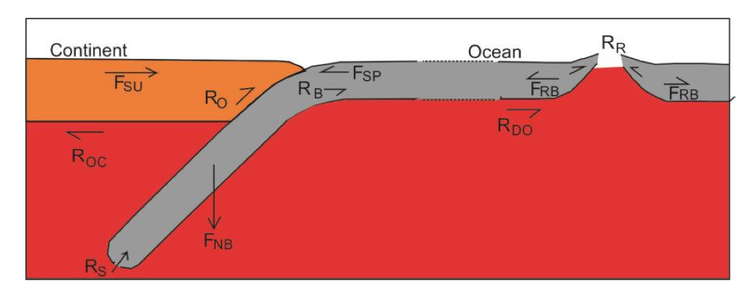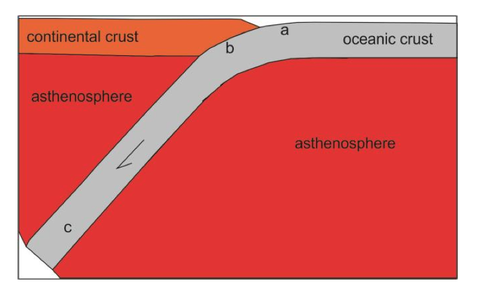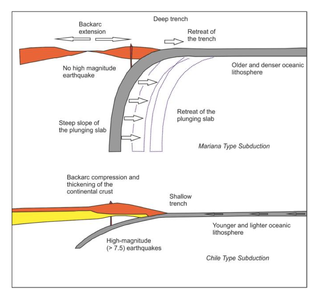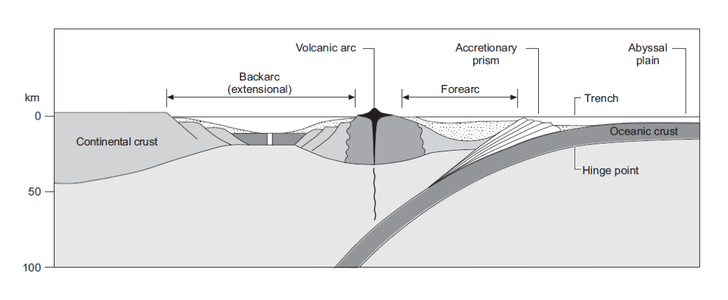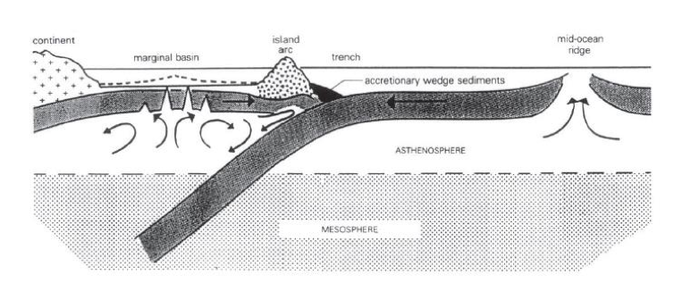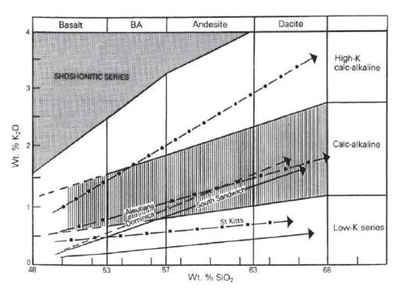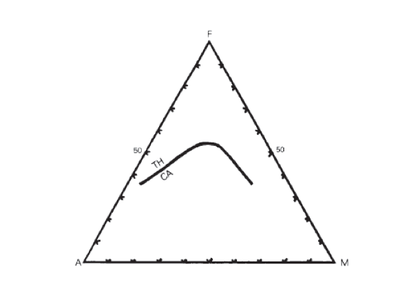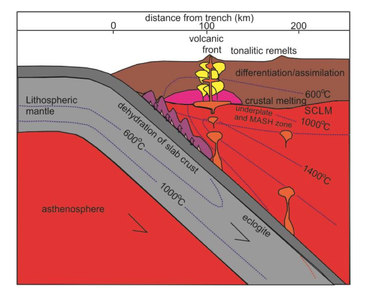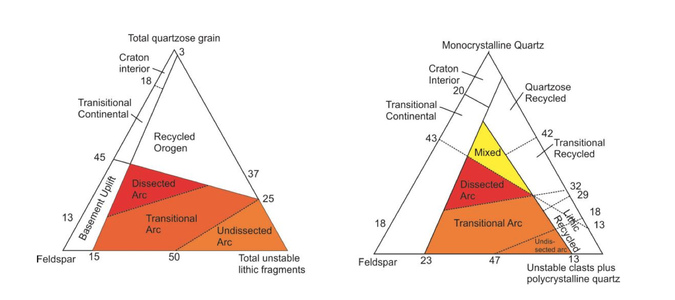Difference between revisions of "Subduction zone"
Cwhitehurst (talk | contribs) |
Cwhitehurst (talk | contribs) |
||
| (5 intermediate revisions by the same user not shown) | |||
| Line 51: | Line 51: | ||
====Backarc Basin==== | ====Backarc Basin==== | ||
| − | Backarc basin forms landward of the volcanic arc. Mechanisms for backarc basin have been proposed by several authors. Karig | + | Backarc basin forms landward of the volcanic arc. Mechanisms for backarc basin have been proposed by several authors. Karig<ref name=Karig1971>Karig, D. E., 1971, Origin and development of marginal basins in the Western Pacific: Journal of Geophysical Research, v. 76, p. 2542-2561</ref> and Keary and Vine<ref name=KV /> stated that the formation of backarc basin is influenced by extensional tectonic regime produced by subduction zone and igneous processes. Basaltic [[mantle]] [[diapir]]s also contribute to the extension of the plate and increasing heat flow. However, Packham and Falvey<ref>Packham, G. A., and D. A. Falvey, 1971, An hypothesis for the formation of marginal seas in the western Pacific: Tectonophysics, v. 11, p. 79-109</ref> proposed that magma upwelling in backarc basin is passive, generated as a result of extensional regime of the plate. Tamaki<ref>Tamaki, K., 1985, Two modes of back-arc spreading: Geology, v. 13, no. 7, p. 475-478.</ref> stated that the initial rifting of backarc basin takes place at the island arc. The dip of subduction zone controls the nature of rifting. Single rifts form within narrow volcanic zone with steeply dipping Benioff zone. On the other hand, multirift system forms in wider zone with shallow angle of subduction. Another concept of backarc basin formation comes from Chase<ref>Chase, C. G., 1978, Plate kinematics: The Americas, East Africa, and the rest of the world: Earth and Planetary Science Letters, v. 37, p. 355–368.</ref> and Fein & Jurdy<ref>Fein, J. B., and D. M. Jurdy, 1986, Plate motion controls on backarc spreading: Geophysical Research Letters, v. 13, p. 456-459</ref>. Regional extension of overriding plate comes from roll-back of the trench. Roll-back occurs when the trench migrates seaward and the oceanic crust retreating. This process produces trench suction force. |
As rifting proceeds in backarc basin, basaltic crust may rise and become the base of the basin. Extensional tectonic regime on overriding plate migrates seaward, generating new backarc basin. Formation of new backarc basin ceases the development of the older one. Time taken for the formation and abandonment of backarc basin requires approximately 20 million years. | As rifting proceeds in backarc basin, basaltic crust may rise and become the base of the basin. Extensional tectonic regime on overriding plate migrates seaward, generating new backarc basin. Formation of new backarc basin ceases the development of the older one. Time taken for the formation and abandonment of backarc basin requires approximately 20 million years. | ||
| − | Karig | + | Karig<ref name=Karig1971 /> classifies backarc basin into three classes: active marginal basin, inactive marginal basin with high heat flow, and inactive marginal basin with normal heat flow. |
==Petrology of Subduction Zone== | ==Petrology of Subduction Zone== | ||
Latest revision as of 20:52, 27 March 2019
| Wiki Write-Off Entry | |
|---|---|

| |
| Student Chapter | Universitas Gadjah Mada |
| Competition | December 2014 |
Subduction zone is one of the most critical tectonic phenomena on Earth. Its correlation to the formation of volcanic arc, deep earthquake, and basins attract the minds of geologists. The profound role of subduction zone emerges as methods in geophysics reveal the structure and composition of materials deep beneath the Earth’s surface.
Principally, subduction zone is the area of the Earth where two plates colliding and the one sinking inside the Earth. The primary cause of subducting slab beside compression is density. Crust with higher density tends to move inside the Earth. According to the types of involved crust, subduction zone has two separate types: island-arc and active continental margin (ACM). Island-arc only involves oceanic crust, while ACM encompasses both continental and oceanic crust.
The Earth’s Crust[edit]
The Earth’s crust triggers the questions of Earth scientists regarding its formation and evolution through time. Continental and oceanic crust makes up nearly three-fourths of the Earth’s body, providing sources of sediment and basement of basins. Continental crust, chemically, tends to have more felsic mineralogical composition than oceanic one.
Divergent plate boundary displays the phenomenon of sea-floor spreading. Mid-Oceanic Ridge (MOR) is the place where magma from below the Earth emerges and crystallizes as oceanic crust. The spreading of the sea-floor causes decompression, triggering partial melting of the source rock. Generation of oceanic crust in MOR enables it to be the youngest crust making up the Earth. No oceanic crust is found to be older than Jurassic.
Due to interaction with seawater, magma crystallizes as pillow lava with basalt composition. Oceanic crust is not homogenous structurally. Keary and Vine[1] divides oceanic crust into three layers. Layer 1, the uppermost part, consists of sedimentary cover varying from pelagic sediments, limestone, clays, and chert. Consolidated sediment and extrusive igneous materials form the Layer 2. Layer 3 gives plutonic foundation with gabbroic composition and consists of serpentinized materials.
Continental crust is found ranging in age from Hadean to recent. The thickness of this crust ranges from 35–40 km and 38 km on average. Continental crust is composed of two layers: upper and lower continental crust. Kearey and Vine[1] stated that upper continental crust is composed of granodiorite and diorite composition. Lower continental crust requires seismic observations since the rock is not exposed on the surface. Seismic velocity, ranging from 6.5 – 7.6 km s-1, represents that rocks are more felsic than basalt constructing the lower continental crust. Roberts and Bally[2], states that granulite or pyroxene granulite forms lower continental crust.
Principles of Subduction Zone[edit]
Forces in Subduction Zone[edit]
Oceanic crust generated in MOR will migrate nearer to the trench. Driving mechanism which influences the dynamics of subduction zone is density. Oceanic crust is denser than continental one, therefore the sinking of oceanic crust below continental crust is possible. Forces driving subduction are ridge-push and slab-pull. As oceanic crust moves away from the ridge, conductive cooling turns the crust to be denser. Density of oceanic crust varies laterally, increasing from the ridge axis to the trench. Such force is parallel to the plate since it pushes in topographic slope. Slab-pull force involves cold, dense oceanic lithosphere and hot, lighter mantle. Slab-pull force dominantly accommodates the vertical displacement of plate. This provides the biggest force for oceanic crust to sink.
Resistive forces are also present in convergent plate boundary. As oceanic crust moves laterally, the base of the plate produces shear resistance, causing deformation of mantle wedge. The contact between oceanic and continental crust along fault plane creates frictional force. On the other hand, when subducted slab enters the depth of 670 km, resistance to penetration occurs because facing discontinuity.
Zonation of Deformation[edit]
Subduction produces areas of different deformation mechanism. Different mechanisms lead to different potential of earthquake. Keary and Vine[1] constructs cross-section of subduction zone consisting three zonations of deformation: a, b, and c. This classification is based on deformation mechanism and materials involved.
Zone ‘a’ represents plastic deformation of oceanic crust plunging into the trench. Flexural bending of oceanic crust creates topographic bulge, causing regional positive gravity anomaly of +500 gu. Zone ‘b’ is the contact of oceanic and continental crust. Compressive forces are built in the overriding crust and extensional regime develops landward on continental crust. As the plate descending to zone ‘c’, the interaction with asthenosphere produces deformation due to unbending of the slab. This mechanism leads to internal deformation of oceanic crust.
Types of Subduction Zone[edit]
Subduction zone induces various surface manifestation and tectonic implications. Subduction zone is divided in two groups according to Jolivet and Nataf:[3] Chilean Type and Mariana Type. The division of subduction zone is based on density of oceanic crust and dip of plunging plate. Chilean Type has younger oceanic crust, gentle dip of plunging plate, strong mechanical coupling implying to strong earthquake, and cordilleran type compressive deformation. On the other hand, Mariana Type has older oceanic crust, steep dip of plunging plate, weak mechanical coupling implying to weak earthquake, and extensional type of deformation of the upper plate.
Structural Features of Subduction Zone[edit]
Ocean Trenches[edit]
Underthrusting of oceanic crust beneath continental crust creates the deepest morphology on Earth: ocean trench. Ocean trench on average has width of 50 – 100 km. As an example, Peru-Chile trench is 4500 km long and has depth of 7 – 8 km below sea level. Great depth of ocean trench implies to its gravity anomalies, reaching negative 2000 gu. On cross-section, trench has V-shaped morphology with angle of steepest slope ranging from 8 – 20o on the opposite side of underthrusting oceanic crust. Sediment supply of oceanic trench depends on accumulated materials (terrigenous, pelagic, or carbonate sediments) on ocean floor.
Accretionary Prism[edit]
Associated structural feature of ocean trench is accretionary prism. Accretionary prism has wedge shape, forming as a result of compressive forces. Sediment accumulation in ocean trench and oceanic crust are scraped in ocean trench because of downgoing plate. Roberts and Bally (2012) stated that accretionary prism may have basin width at least 100 km with ophiolitic basement and 15 – 20 km thick of sediment. Components building the prism may come from oceanic plate, clinoform toes of passive margin, and arc-derived detritus.
Accretionary prism has imbricate listric thrust dipping towards the arc. As subduction progresses, the listric fault has increasing dip and rotation towards the arc. An good analogy of accretionary prism formation is sand crushed by a bulldozer. Sand accumulation will experience “compression” from bulldozer, forming sand wedge as the bulldozer moving. Sand wedge will increase in dip until it reaches its angle of repose.
Imbricate listric thrust also implies to the order of age. Older sediments and metamorphic rocks certainly have experienced more intensive deformation than the younger ones. As a consequence, the older part must have existed in structural high. This transportation enables the discovery of old sediments and metamorphic rocks on the uppermost part of accretionary prism.
[edit]
Subduction zone generates zone of accumulation of sediments in the trench and on overriding plate. Trench becomes sites of deposition for marine sediments and also for sediments brought by the downgoing plate. Characteristic deposit in trench is mélange. Boggs[4]defines mélange as mixed assemblage of rock consisting of brecciated blocks in a highly shear matrix. Zone of accumulation on the overriding plate includes forearc, backarc, intraarc, and retro-arc basins. The formation of extensional regime in subduction zone is related to the angle of downgoing plate. As discussed before, subduction zone with steep angle of downgoing plate generates extensional forces on the overriding plate.
Forearc Basin[edit]
Forearc basin forms between the volcanic arc and the trench. Volcanic arc and accretionary prism borders the edge of forearc basin. Dimension of forearc basin depends on the arc-trench gap. Continental margin or oceanic crust may form the base of forearc basin. Concerning its capacity to accumulate sediments, rate of subsidence of forearc basin is controlled by sediment loading.
On sedimentological aspects, forearc basin essentially has volcanic arc as provenance and change in depositional environment may occur. Volcanic materials may always exist in successions deposited in forearc basin. Macdonald and Butterworth[5] explains that depositional environment in forearc basin may evolove from deep-water deposit, shallow-marine deposit, deltaic deposit, and fluvial deposit on top.
Backarc Basin[edit]
Backarc basin forms landward of the volcanic arc. Mechanisms for backarc basin have been proposed by several authors. Karig[6] and Keary and Vine[1] stated that the formation of backarc basin is influenced by extensional tectonic regime produced by subduction zone and igneous processes. Basaltic mantle diapirs also contribute to the extension of the plate and increasing heat flow. However, Packham and Falvey[7] proposed that magma upwelling in backarc basin is passive, generated as a result of extensional regime of the plate. Tamaki[8] stated that the initial rifting of backarc basin takes place at the island arc. The dip of subduction zone controls the nature of rifting. Single rifts form within narrow volcanic zone with steeply dipping Benioff zone. On the other hand, multirift system forms in wider zone with shallow angle of subduction. Another concept of backarc basin formation comes from Chase[9] and Fein & Jurdy[10]. Regional extension of overriding plate comes from roll-back of the trench. Roll-back occurs when the trench migrates seaward and the oceanic crust retreating. This process produces trench suction force.
As rifting proceeds in backarc basin, basaltic crust may rise and become the base of the basin. Extensional tectonic regime on overriding plate migrates seaward, generating new backarc basin. Formation of new backarc basin ceases the development of the older one. Time taken for the formation and abandonment of backarc basin requires approximately 20 million years.
Karig[6] classifies backarc basin into three classes: active marginal basin, inactive marginal basin with high heat flow, and inactive marginal basin with normal heat flow.
Petrology of Subduction Zone[edit]
Igneous Petrology[edit]
Thermal Structure of Subduction Zone[edit]
Thermal structure of subduction zone encompasses various factors affecting magma generation. Temperature distribution of subducted slab depends on physical properties of the slab, amount of water involved, and kinematics of the plate. Due to its solid phase, oceanic crust needs intensive interaction with heat source to distribute thermal energy through conduction. Keary and Vine[1] proposed seven factors affecting thermal structure of subducted slab:
- The rate of subduction
- Slow rate of subduction enables heat to widely distributed into the slab.
- Thickness of subducted slab
- Thick oceanic crust has slower rate of heat conduction.
- Frictional heating of upper and lower surfaces of the slab
- Frictions of the slab with overriding plate and underlying asthenosphere produce heat.
- Heat conduction from the asthenosphere to the slab
- Physical properties of the oceanic crust and asthenosphere influence the rate of heat conduction.
- Adiabatic heating associated with compression of the slab as pressure increasing with depth Compression as a result of increasing pressure also generates heat.
- Heat produced by radioactive decay
- Latent heat produced by phase transition of minerals into denser crystalline structure.
- Transition of olivine to spinel at depth of about 400 km is exothermic, while spine to oxide trasition at depth of about 640 km may be exothermic or endothermic.
Magma Generation[edit]
Volcanic arc above subduction zone is a manifestation of magma generation below the Earth’s surface. Magma generation in subduction zone focuses on the potential sources of partial melting, mechanism of partial melting, and types of magma generated. Magma generated in subduction zone will ascent to the surface as a consequence of buoyancy. Assimilation and fractional crystallization (AFC) will take place, especially in active continental margin.
Potential sources of magma generation are the subducted oceanic crust, mantle wedge, and sea water. Oceanic crust, as previously discussed, consists of terrigenous, carbonate and pelagic sediments, and also sedimentary rock, basalt, and gabbro. Mantle wedge as a part of asthenosphere provides lherzolite and harzburgite. Sea water doesn’t provide silicate materials in magma generation. Otherwise, sea water takes a role in reducing solidus of silicate material. As a result, partial melting can be achieved at lower temperature. Water may reduce the temperature of partial melting about 300oC. Wilson[11] proposed specific potential sources of partial melting:
- Amphibolite, with or without aqueous fluid
- Eclogite, with or without aqueous fluid
- Lherzolite with aqueous fluid
- Lherzolite modified by reaction with hydrous siliceous magma
Magma generation of subduction zone greatly involves dehydration process. Prograde metamorphism occurs as the plate subducting. Increasing pressure and temperature dehydrate OH-bearing minerals, such as hornblende and biotite. Zeolite may prograde to amphibolite facies, then to eclogite facies. Water produced from metamorphism may occur at depth of 80 – 125 km. As water generated, it migrates upward as intergranular fluid. Water supply from subducted slab lowers the solidus of the mantle wedge.
Magma generated from mantle wedge in dry condition is basaltic or picritic in composition.[11] The presence of volatiles (H2O and CO2) can produce magma with higher silica content. Andesite can be directly produced from mantle wedge at depth less than 40 km with concentration of H2O of 15 wt. %[12][13]
Boron, beryllium, thorium, and lead are possible indicators in determining the mode of flow within mantle wedge. Boron indicates transportation by fluid, while thorium and beryllium are effectively transported by melts.
Geochemistry of Subduction Zone Igneous Rocks[edit]
Types of Earth’s crust involved in subduction zone are critical in recognizing the geochemical characteristics of igneous rocks. Igneous petrology classifies subduction-related activity as island-arc and active continental margin. Island-arc only involves oceanic crust in subduction zone. Meanwhile, active continental margin involves both continental and oceanic crust. The two systems generally have similar igneous processes. The difference lies in the more intensive assimilation and fractional crystallization in active continental margin.
Island-arc[edit]
Classification of igneous rocks in geochemistry utilizes the alkaline (K2O and Na2O) and silica content of the rock. Classification based on alkaline and silica content divides igneous rock as alkaline and subalkaline rock. Plotting of K2O and Na2O may be conducted in separate graphs. If the plot in K2O graph states the rock is alkaline while in Na2O says the rock is subalkaline, then the rock is classified as transitional. Graph for alkaline and silica content plotting will be given in Fig. 7 and Fig. 8.
Igneous rocks generated in subduction zone generally belong to subalkaline rock. Plotting of K2O and Na2O in Harker diagram produces for classes of subduction magma series: low-K series, calc-alkaline series, high-K series, and shoshonitic series. Potash content in igneous rock is critical because it can represent the degree of contamination of magma. Low-K series is the same as tholeiitic rock. Calc-alkaline magma series have high alumina content. Shoshonitic series represents alkaline rock. Miyashiro (1974) in Wilson[11] reveals the difference between calc-alkaline magma series with tholeiitic magma through Fe content. Calc- alkaline magma series show decreasing content of FeO in increasing SiO2 content. Otherwise, tholeiitic magma series show enrichment of Fe in early stage of fractionation.
Tholeiitic rock of subduction zone produces basalt and basaltic andesite. With its mafic composition, tholeiitic rock doesn’t produce explosive materials, such as pyroclastic fall and flow. Amphibole and biotite may be absent due to low volatile content. Another implication lies in geometry of volcano. Because of low viscosity, tholeiitic magma series tend to build shield volcano.
Calc-alkaline magma series principally generates two-pyroxene andesite with about 59% SiO2.[11] Increasing viscosity of magma implies to more explosive eruption and geometry of volcano. Due to explosive eruption, calc-alkaline magma is able to produce pyroclastic materials. In addition, calc- alkaline magma series build stratovolcano geometry.
Spatial and Temporal Distribution of Island-arc Magma Series[edit]
Geochemistry of igneous rocks in subduction zone is not constant in time and space. The evolution of magma series occurs because of subduction geometry and time. Spatial distribution of magma series builds on K – h relationship proposed by Dickinson (1975) in Wilson.[11] If silica content is hold constant, the amount of K2O (K) will increase as depth of Benioff zone (h) deepening. Therefore, volcano will produce rock of increasing alkalinity as it migrates away from the trench. Reversal of this characteristic also occurs. Relationship of magma series and time is represented with increasing alkalinity as time progresses. Deeper knowledge is required to build a model for temporal distribution as it is currently poorly understood.
Active Continental Margin[edit]
Active continental margin becomes the most complicated site of magma generation of Earth. As discussed in previous section, magma generation begins at the slab and mantle wedge. Partial melting of mantle wedge generates basaltic primitive magma. In island-arc, primitive magma rises to the surface and builds basaltic or andesitic volcano. Igneous processes in island-arc differ with active continental margin in assimilation and fractional crystallization.
Primitive magma generated from the mantle wedge ascent to the boundary of crust and mantle. Due to density contrast, magma from mantle wedge underplates at the base of crust and experiences melting, assimilation, storage, and homogenization (MASH). Assimilation occurs because the crust is molten and enriching the composition of ascending magma. Winter[14] defines fractionation as mechanical separation of materials with distinct phases. Simplified explanation of fractional crystallization is represented in Bowen reaction series. Magma will ascent from the base of the crust when faults creating fractures for magma migration. This requirement may occur in thinning area.
Assimilation and fractional crystallization of magma in the continents depends on the type of the crust. Continental crust itself is generally divided as upper and lower parts, represented with distinctive composition as previously discussed. With several possibilities of interaction, assimilation and fractional crystallization of magma have different Sr, Nd, Pb, and O isotopic signature. The use of Sr, Nd, and Pb data for interpreting young continental crust may trigger misleading result. Since young continental crust may have slightly different composition with the primitive magma, the data will show that contamination doesn’t occur. Winter[14] states that assimilation and fractional crystallization in the deep-level generates magma with higher concentrations of K2O, Rb, Cs, Ba, Th, and Light Rare Earth Elements (LREE). Assimilation in active continental margin depends on temperature, composition, and thickness of the crust.
Sedimentary Petrology[edit]
Subduction zone has distinctive characteristics in affecting sedimentary rocks forming in an area. The effect of subduction zone ranges from basin formation to provenance. As discussed previously, subduction zone creates three zones of accumulation: the trench, forearc basin, and backarc basin. The three zones have distinguished characteristics, from mechanics to sediment filling.
Provenance of Sedimentary Rock in Subduction Zone[edit]
Provenance of sedimentary rocks can be divided in three types:[4] continental block provenances, recycled orogen provenances, and magmatic arc provenances. Sediments in continental block provenances come from the interior of the plate. Sediments may come from plutonic igneous rocks, metamorphic rocks, and pre-existing sedimentary rocks. Volcanic rocks take part less than other sources. Recycled orogen provenances occur in plate collision. The uplift caused by this process generates various types of rock as sediment source. Conclusively, types of sediment source in recycled orogen are derived from components of oceanic and continental crust: ultramafic rocks, basalt, limestone, shale, and others.
Provenance of sedimentary rocks in subduction zone originates from magmatic-arc. Sediment sources in magmatic-arc provenances come primarily from volcanic rocks. Geochemistry of igneous rock generated in subduction zone depends of the types of crust involved. Island-arc and active continental margin settings provide different proportions of types of minerals. Island-arc tends to produce basalt and andesite, while active continental margin generate volcanic rocks based on degree of assimilation and fractional crystallization of primitive magma.
Dickinson et. al.[15] builds two classifications of provenances based on mineral composition in sandstone. Total quatzose grain, feldspar, and total unstable lithic fragments form one classification, and monocrystalline quartz, feldspar, and unstable clasts plus polycrystalline quartz. The detail of this classification can be reached in Figure 9.
Magmatic-arc provenances encompass undissected arc, transitional arc, and dissected arc. Undissected arc provides sediments from volcanogenic highlands, where the volcano has not been eroded intensively. Major composition of sandstone from this source is unstable lithic fragments. As volcanism ceases and plutonic rock exposed, undissected arc turns out to be dissected arc. Dissected arc has higher proportion of quarzose grains and feldspar than undissected arc. Transitional arc lies between the two.
Metamorphic Petrology[edit]
Subduction zone has distinct metamorphic rocks: formation of jadeite and glaucophane of blueschist faceis. Metamorphism in subduction zone is related to dewatering processes in magma generation. Dewatering and higher pressure and temperature induce prograde metamorphism. Keary and Vine[1] states that surface volcanism is related to the formation of andalusite, high temperature and low pressure mineral. Miyashiro (1973) in Keary and Vine[1] states that subduction zone has paired metamorphic belts. An outher high pressure/low temperature on the seaward and low pressure/high temperature belt of similar age associated with the island arc.
Fig. 1. Forces in Subduction Zone (Derived and modified from Keary and Vine)[1]
Fig. 2. Zonation of Deformation in Subduction Zone. This figure models the explanation above. (Derived and modified from Keary and Vine)[1]
Fig. 3. Types of Subduction Zone (Derived from Jolivet and Nataf)[3]
Fig. 4. Structural Features of Subduction Zone (Derived from Nichols)[16]
Fig. 5. Schematic Model of Island-arc (Derived from Wilson)[11]
Fig. 6. Plot of wt.% K2O versus wt.% SiO2 to Show Major Divisions of Island-arc Volcanic Suites (Derived from Wilson)[11]
Fig. 7. Plot of A = K2O + Na2O, F = FeO + 0,9Fe2O3, and M = MgO to Differentiate between Tholeiitic and Calc-alkaline Magma Series (Derived from Wilson)[11]
Fig. 8. Schematic Model of Subduction Zone in Active Continental Margin (Derived from Winter)[14]
Fig. 9. Classification of Tectonic Settings based on Mineral Composition in Sandstone (Derived from Dickinson et. al. (1983) in Boggs[4])
References[edit]
- ↑ 1.0 1.1 1.2 1.3 1.4 1.5 1.6 1.7 1.8 Keary, P. and F. J. Vine, 1994, Geoscience Texts: Global Tectonics. Oxford: Blackwell Scientific Publications.
- ↑ Roberts, D. G., and A. W. Bally, 2012, Regional geology and tectonics: Elsevier
- ↑ 3.0 3.1 Jolivet, L., and H.-C. Nataf, 2001, Geodynamics. Dunod: A. A. Balkema.
- ↑ 4.0 4.1 4.2 Boggs, S., Jr., 2011, Principles of Sedimentology and Stratigraphy Fifth Edition. New Jersey: Pearson Prentice Hall.
- ↑ Macdonald, D. I., and P. J. Butterworth, 1990, The stratigraphy, setting and hydrocarbon potential of the Mesozoic sedimentary basins of the Antarctic Peninsula, in St. John, B., ed., Antarctica as an exploration frontier--Hydrocarbon potential, geology, and hazards: AAPG Studies in Geology 31, p. 101-125
- ↑ 6.0 6.1 Karig, D. E., 1971, Origin and development of marginal basins in the Western Pacific: Journal of Geophysical Research, v. 76, p. 2542-2561
- ↑ Packham, G. A., and D. A. Falvey, 1971, An hypothesis for the formation of marginal seas in the western Pacific: Tectonophysics, v. 11, p. 79-109
- ↑ Tamaki, K., 1985, Two modes of back-arc spreading: Geology, v. 13, no. 7, p. 475-478.
- ↑ Chase, C. G., 1978, Plate kinematics: The Americas, East Africa, and the rest of the world: Earth and Planetary Science Letters, v. 37, p. 355–368.
- ↑ Fein, J. B., and D. M. Jurdy, 1986, Plate motion controls on backarc spreading: Geophysical Research Letters, v. 13, p. 456-459
- ↑ 11.0 11.1 11.2 11.3 11.4 11.5 11.6 11.7 Wilson, M., 2007, Igneous Petrogenesis: A Global Tectonic Approach. Dordrecht: Springer.
- ↑ Mysen, B.O., 1982, The role of mantle anatexis, in R. S. Thorpe (ed.), Andesites: orogenic andesites and related rocks, Chichester: Wiley, pp. 489–522.
- ↑ Wyllie, P. J., 1982, Subduction products according to experimental prediction: Geological Society of America Bulletin, vol. 93, pp. 468-476.
- ↑ 14.0 14.1 14.2 Winter, J. D. 2001, An Introduction to Igneous and Metamorphic Petrology. New Jersey: Prentice-Hall Inc.
- ↑ Dickinson, W. R., L. S. Beard, G. R. Brakenridge, J. L. Er javec, R. C. Ferguson, K. F. Inman, R. A. Knepp, F. A. Lindberg, and P. T. Ryberg, 1983, Provenance of North American Phanerozic sandstones in relation to tecton ic setting: Geol. Soc. America Bull, v. 94, p. 222-235.
- ↑ Nichols, G., 2009, Sedimentology and Stratigraphy Second Edition. West Sussex: John Wiley & Sons Ltd.
Other Sources[edit]
- Plummer, C. C., Carlson, Diane H., and Hammersley, Lisa. 2013. Physical Geology Fourteenth Edition. New York: McGraw-Hill Companies, Inc.
